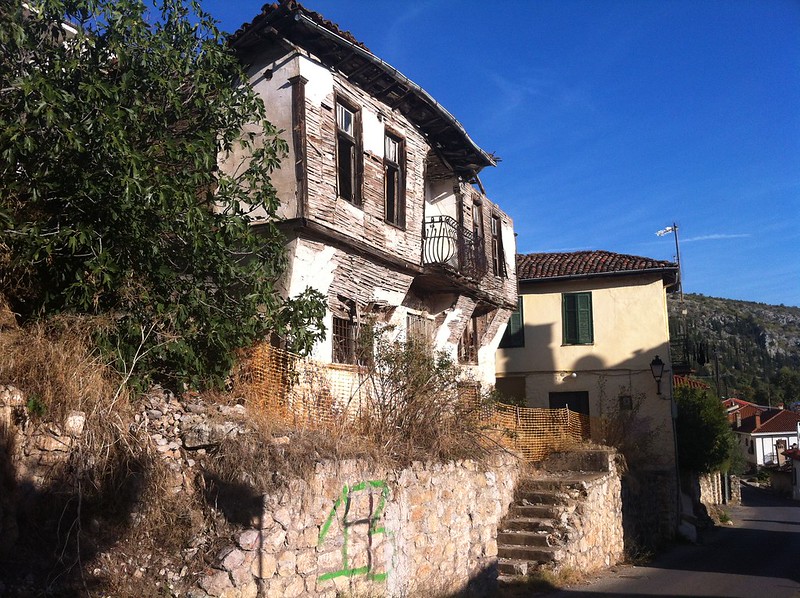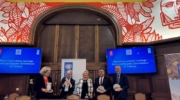European experts present Report for the Restoration of Historic Areas in Kastoria
Europa Nostra, the leading European heritage organisation, and the Council of Europe Development Bank (CEB) published today the technical and financial report for the rehabilitation of historic areas in the neighbourhoods of Dolcho and Apozari in Kastoria in Greece, listed among ‘The 7 Most Endangered’ heritage sites in Europe in 2014, following a nomination by Elliniki Etairia – Society for the Environment and Cultural Heritage in cooperation with the local municipality.

“The two neighbourhoods have huge development potential based on their urban, environmental, natural and cultural wealth. A series of actions need to be urgently implemented in order to preserve their exceptional heritage,” highlights the independent report led by Pedro Ponce de Léon, Member of the Scientific Council of Europa Nostra, who also acted on behalf of the CEB.
Kastoria has an unequalled number of medieval churches dating from the 9th to the 15th centuries, while its 18th-19th century mansions are among the finest in the wider region. Dolcho and Apozari contain 370 listed buildings, 351 in private and 19 in public hands. Of the 351 privately-owned buildings, 120 are in a poor state of conservation, 146 are in a moderate state and 25 have been completely destroyed; only 60 have been restored.
A large local demand for housing and business spaces in the two neighbourhoods has been identified; therefore an urban regeneration plan is considered feasible. The implementation of a programme of social housing development, and incentives for the rehabilitation and reuse of the buildings could be a successful initiative. Private owners should be helped via fiscal aid, subsidies or tax incentives, and encouraged to add value to and improve their properties. To meet that challenge it is necessary to establish a plan in which residential, arts and crafts and small businesses are fundamental (and undoubtedly coherent, desirable and compatible within areas of historical value).
It is proposed to create a pilot area per neighbourhood, covering approximately 10% of its total area. Dolcho’s pilot area would feature 18 historic buildings, while Apozari’s pilot area would include 22 historic buildings. The estimated cost for the rehabilitation of the two pilot areas is in the range of 10 million euros (excluding VAT).
“The development of pilot schemes in the future will extend the experience of rehabilitation to the rest of the city in a programme of long-term investments. To succeed, the Dolcho and Apozari neighborhoods restoration process should be undertaken in phases, given its size and complexity. These phases should extend over several years, with a plan of gradual investments,” states the report.
It is considered essential to establish a technical office in Kastoria able to guide the process, both technically and administratively. This office, comprised mostly of local technicians with external advisors, will assume the management, development and monitoring of projects and actions, with the necessary facilitation and dialogue with the local, regional and national administrations. It will also be responsible for preparing and running a Cultural Heritage Integrated Management Plan.
An integrated approach will support the protection of cultural heritage assets and the sustainable development of the urban areas whilst respecting the social and economic interests of all the public and private stakeholders. The listed buildings will be repaired with historical and reversibility criteria, including energy optimisation and habitability improvement. Furthermore, the restoration process can be used to train and qualify young people in arts and crafts or ancient techniques, thus helping to reduce the high-levels of unemployment in the area.
The Government must drive the actions by its own example, facilitating the use of their own buildings or moving municipal offices currently leasing the mansions in Dolcho and Apozari. Similarly, the administration should be the catalyst for other stakeholders, both public and private, implementing measures to promote investment.
According to the report, funding should not simply be based on (repayable) loans, but rather on a combination of these with grants, guarantees, donations, revenues and other non-repayable funding streams. The European Regional Development Fund, the European Social Fund, the EU Creative Europe programme and the JESSICA programme are listed as possible sources, among others.
This report was prepared on the basis of the outcomes of the five-day mission in Kastoria undertaken in October and November 2014, during which representatives from Europa Nostra, the Council of the Europe Development Bank and Elliniki Etairia visited numerous historic buildings and met local, regional and national stakeholders. It was funded by the CEB through its Spanish Social Cohesion Account.
Europa Nostra and the European Investment Bank Institute, founding partner of ‘The 7 Most Endangered’ programme, will announce in the coming weeks the technical and financial reports for the historic stage machinery of the Bourla theatre in Antwerp in Belgium and the synagogue in Subotica in Serbia. The action plans for the other heritage sites listed for ‘The 7 Most Endangered’ 2014 have already been unveiled: the Citadel of Alessandria in Italy (3 July), the carillons of the Mafra National Palace in Portugal (6 March), and the wooden churches in Southern Transylvania and Northern Oltenia in Romania (5 March). A working meeting about the Colour Row Settlement in Russia took place in The Hague on 29 May 2015.






